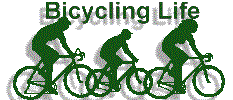| Bicycling Life |
About Our Site
Issues & Editorials
Solutions for Little
Problems,
Adjustments, and Repairs.
Using Bikes in Everyday
Life
Commuting & Errands
Cycling for Fun &
Health
Street Smarts for Bicyclists
Safety Issues
Advancing Cycling Issues
Getting Involved
Position Papers
Research and
Source Documents
|
| |
|
  Road Vogue Road Vogue
|
A Guide to Classy Bicycling
By Wayne
Pein, Chapel Hill, North Carolina
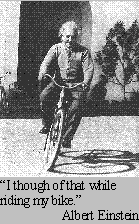 Riding a bicycle is a great way to get around,
fabulous exercise, and flat out fun. Bicycling helps keep you young, or at least young at
heart! You can save money, parking hassle, and sometimes even time by not driving. A
bicycle is inexpensive to purchase and maintain, and is the environmentalist's dream
machine. You might even have a world changing idea while pounding the pedals! Riding a bicycle is a great way to get around,
fabulous exercise, and flat out fun. Bicycling helps keep you young, or at least young at
heart! You can save money, parking hassle, and sometimes even time by not driving. A
bicycle is inexpensive to purchase and maintain, and is the environmentalist's dream
machine. You might even have a world changing idea while pounding the pedals! How are
all the best bicyclists riding nowadays? Be chic by knowing these Spoke 'n' Words.
It ain't rocket science! |
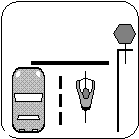 A. Bicycles are Legal Vehicles. A. Bicycles are Legal Vehicles.
§20-4.01 (49) of the North Carolina traffic code states: "...for the purposes of
this Chapter bicycles shall be deemed vehicles and every rider of a bicycle upon a highway
shall be subject to the provisions of this Chapter applicable to the driver of a vehicle
except those which by their nature can have no application."
The traffic codes of other states are similar. In every state, a bicycle is either
classified as a vehicle or the operator is given "all the rights and
responsibilities" (exact words vary) of an operator of a vehicle. See Bicycling Laws of the United States to find
your state's code.
Same Roads. Same Rights. Same Rules. Bikes Belong, so ride like it. But, with rights
come responsibilities. Obey all laws, signs, and signals. Two wheels or four, the law is
the law. And it's a lot safer following traffic rules than not. |
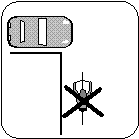 B. Go With the Flow.
Ride Right with traffic, not facing traffic. Motorists often do not look for wrong way
bicyclists, and correct riding bicyclists are put into danger by wrong way riders who are
in the same path. B. Go With the Flow.
Ride Right with traffic, not facing traffic. Motorists often do not look for wrong way
bicyclists, and correct riding bicyclists are put into danger by wrong way riders who are
in the same path. |
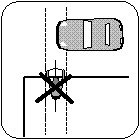 C. Skip the Sidewalk.
Drivers typically pull out at driveways or intersections without first stopping prior to
the sidewalk or crosswalk. Turning vehicles, pedestrians, visual and physical
obstructions, and the narrowness of the sidewalk create other hazards. Don't ride on
sidewalks, but if you do where not specifically illegal, ride slowly, alert pedestrians,
and be prepared to yield at all junctions. There's a reason they are called
"sideWALKS!" C. Skip the Sidewalk.
Drivers typically pull out at driveways or intersections without first stopping prior to
the sidewalk or crosswalk. Turning vehicles, pedestrians, visual and physical
obstructions, and the narrowness of the sidewalk create other hazards. Don't ride on
sidewalks, but if you do where not specifically illegal, ride slowly, alert pedestrians,
and be prepared to yield at all junctions. There's a reason they are called
"sideWALKS!" |
 D. Appealing Yielding.
At intersections and driveways, yield to the traffic on the "bigger" road. Yield
when changing lanes or before making any lateral move, shoulder checking (looking behind)
until there is no close traffic. Communicate your intentions with hand signals. D. Appealing Yielding.
At intersections and driveways, yield to the traffic on the "bigger" road. Yield
when changing lanes or before making any lateral move, shoulder checking (looking behind)
until there is no close traffic. Communicate your intentions with hand signals. |
 E. Speed Sense. For
ALL vehicles, slower traffic keeps to the right, but this does not mean bicycles should
teeter on the edge. Hugging the edge of a narrow lane encourages motorists to try to
squeeze by. Riding closer to motor traffic may seem counterintuitive, but it makes you
more visible to drivers who are overtaking, oncoming, or pulling out of side streets and
driveways. It helps prevent the "Left Cross" (see F. 1. ), the "Right
Hook" (F. 2.), and gives you more room to maneuver. "Use the full lane" if you
are moving near or at the speed limit, the lane is too narrow for safe overtaking, or if
you are avoiding parked car doors or other road side hazards. E. Speed Sense. For
ALL vehicles, slower traffic keeps to the right, but this does not mean bicycles should
teeter on the edge. Hugging the edge of a narrow lane encourages motorists to try to
squeeze by. Riding closer to motor traffic may seem counterintuitive, but it makes you
more visible to drivers who are overtaking, oncoming, or pulling out of side streets and
driveways. It helps prevent the "Left Cross" (see F. 1. ), the "Right
Hook" (F. 2.), and gives you more room to maneuver. "Use the full lane" if you
are moving near or at the speed limit, the lane is too narrow for safe overtaking, or if
you are avoiding parked car doors or other road side hazards. |
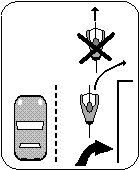 F. Intersection Intelligence.
Approach intersections in the correct position for your destination. Turn left near the
center line, right near the curb, and for straight thru in between these extremes. Follow
lane markings; do not go straight in a right turn only lane. When turning, convey your
intention with hand signals and proper positioning. When going straight, keep pedaling
rather than coasting. It is not advisable to pass stopped motor vehicles on their right,
but if you do, assume they will turn right even if not signaling. F. Intersection Intelligence.
Approach intersections in the correct position for your destination. Turn left near the
center line, right near the curb, and for straight thru in between these extremes. Follow
lane markings; do not go straight in a right turn only lane. When turning, convey your
intention with hand signals and proper positioning. When going straight, keep pedaling
rather than coasting. It is not advisable to pass stopped motor vehicles on their right,
but if you do, assume they will turn right even if not signaling. |
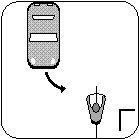 1. Watch for the "Left
Cross." Left turning motorists tend to look down the center of the lane for other
motor vehicles, and are less likely to notice bicyclists who are close to the curb and
smaller. Avoid this danger by being vigilant, and more visible by positioning yourself
closer to, or even straight down, the middle of the lane. Keep from being visually
screened by other motor vehicles. 1. Watch for the "Left
Cross." Left turning motorists tend to look down the center of the lane for other
motor vehicles, and are less likely to notice bicyclists who are close to the curb and
smaller. Avoid this danger by being vigilant, and more visible by positioning yourself
closer to, or even straight down, the middle of the lane. Keep from being visually
screened by other motor vehicles.
|
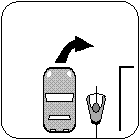 2. Fend off the "Right
Hook." Motorists sometimes overtake bicyclists only to wind up cutting them off
when making a right turn. Guard against this type of danger by being further from the
curb, forcing the driver to make a more sweeping turn. Expect the "right hook"
to happen, and be able to "Instaturn" (G. 1.) if necessary. 2. Fend off the "Right
Hook." Motorists sometimes overtake bicyclists only to wind up cutting them off
when making a right turn. Guard against this type of danger by being further from the
curb, forcing the driver to make a more sweeping turn. Expect the "right hook"
to happen, and be able to "Instaturn" (G. 1.) if necessary.
|
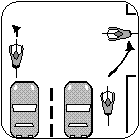 3. Turning left. There are two
ways to turn left: "vehicular" style and "2 Step" style. It should
rarely be a necessity, but use a "2 Step" turn if traffic is too heavy for you
to turn left like other vehicles. Go through the intersection, align yourself facing left,
and proceed when clear or on the green if at a signal. 3. Turning left. There are two
ways to turn left: "vehicular" style and "2 Step" style. It should
rarely be a necessity, but use a "2 Step" turn if traffic is too heavy for you
to turn left like other vehicles. Go through the intersection, align yourself facing left,
and proceed when clear or on the green if at a signal.
|
| G. Know these Skills. Be able to ride a straight line, including while starting
and stopping, riding very slowly, "shoulder checking" behind, and hand
signaling. Though you should be able to avoid hazardous situations by planning ahead,
learning how to "Instaturn," "Quick Dodge," and "Panic Stop"
can provide emergency backup. |
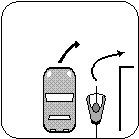 1.
Instaturn. Use this to make an emergency right turn to avoid the "Left
Cross," "Right Hook," or motorists not yielding when pulling out of
driveways. To execute, briefly steer left first, which allows the bike to easily lean
right, then enabling a sharp right turn. 1.
Instaturn. Use this to make an emergency right turn to avoid the "Left
Cross," "Right Hook," or motorists not yielding when pulling out of
driveways. To execute, briefly steer left first, which allows the bike to easily lean
right, then enabling a sharp right turn.
|
2. Panic Stop. Emergency stop by shifting your weight back, straightening your
arms, and using both brakes. If the rear skids, ease up on both brakes. Know the limits of
your front wheel to avoid a dangerous front skid.
|
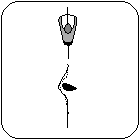 3. Quick Dodge. Watch out for
road surface hazards: potholes, large rocks, gravel, bad drainage grates or other slots in
the direction of travel, wet metal surfaces, and assorted debris. Avoid sudden unforeseen
hazards such as potholes by turning left then right back quickly around the object. The
rear wheel should also miss the threat. You may also "bunny hop" a hazard. If
you must ride over something, rise off the saddle and use your legs like shock absorbers. 3. Quick Dodge. Watch out for
road surface hazards: potholes, large rocks, gravel, bad drainage grates or other slots in
the direction of travel, wet metal surfaces, and assorted debris. Avoid sudden unforeseen
hazards such as potholes by turning left then right back quickly around the object. The
rear wheel should also miss the threat. You may also "bunny hop" a hazard. If
you must ride over something, rise off the saddle and use your legs like shock absorbers.
|
H. Be Smartly Outfitted. Injuries can occur because you and your
bike are not properly equipped.
1. The Alright Bike. Ensure the bicycle is correctly fit for you, is in proper
working order, and that you are competent with all operating controls. Keep tires
pumped to avoid "snake bite" flats, and carry a spare tube, pump, patch kit,
tire levers, and a multi tool for the inevitable problem. It helps to have a basic
knowledge of how to adjust brakes and gears. It's not quantum mechanics!
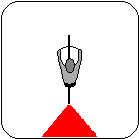 2. Be Visible at Night. Use front
and rear lights and reflectors at night. Reflectors alone are not sufficient. 2. Be Visible at Night. Use front
and rear lights and reflectors at night. Reflectors alone are not sufficient.
North Carolina law §20-129. (e) states: "Every bicycle shall be equipped with a
lighted lamp on the front thereof, visible under normal atmospheric conditions from a
distance of at least 300 feet in front of such bicycle, and shall also be equipped with a
reflex mirror or lamp on the rear, exhibiting a red light
visible under like conditions from a distance of at least 200 feet to the rear of such
bicycle, when used at night." All states require lights at night. Most require
white in front and red in back.
3. Be Seen During Daylight. Bright clothing catches people's attention during
daylight. But the best way to be seen is to be in the scene, in drivers' line of sight.
Ride as if you are HUGE.
4. Use Protective Clothing and Gear. A helmet and glasses help protect
irreparable parts of your body, and stiff-soled bicycling-specific footwear and padded
shorts makes rides, especially longer ones, easier on your feet and bottom. Slathering
sunscreen shields you from photons.
|
| I. Help for Harassment. Should you find yourself the victim of other
people's bitterness, ignorance, smallness or insecurities; remember, things could be
worse. You could be them! The best course of action when you're harassed is to first
take a deep breath and calmly decide whether you were actually purposefully mistreated or
whether your perceptions could have misled you. Drivers may inadvertently do
something that appears threatening and purposeful, but is simply a lack of awareness.
If indeed some braze-on dropout has derailleured you or otherwise been a pain in your
bottom bracket, keep your headset, Quick Dodge your anger, memorize or write the
offender's license plate number and as much detail about the situation, driver, and
vehicle as possible, and file a report with the police.
You're doing other bicyclists a great service by reporting all incidents. The police
look for trends. If license plate LUGNUT is reported by more than one bicyclist, the
police will know. |
| J. Wheely Wise Words. Be cautious not timid; assertive not
aggressive. Don't ride in the gutter pan, near the extreme edge of the road, or on
the sidewalk. Watch for road surface hazards such as potholes, sand and gravel, bad
drainage grates or other slots in the direction of travel, wet metal and painted surfaces,
and assorted debris and irregularities. Inform your community's maintenance
department. Ride confidently as a legal and lawful user of the roadways. It is an
important and legitimate technique for bicyclists to occasionally control overtaking motor
vehicles by being farther out into or even taking the lane. It may seem dangerous or
illegal to make a motorist slow for you, but it is not (provided, of course, the driver is
given ample opportunity to react to your presence).
Getting passed by fast moving, large, and loud motor vehicles can be intimidating.
However, getting hit from behind is NOT a likely collision, unless you ride at night with
no rear lights and reflectors. Skilled bicyclists are almost never involved in an
overtaking crash, or any other type crash for that matter. So don't fear a near
non-existent problem or create new ones by fearful riding practices! |
|
  |
|
|
